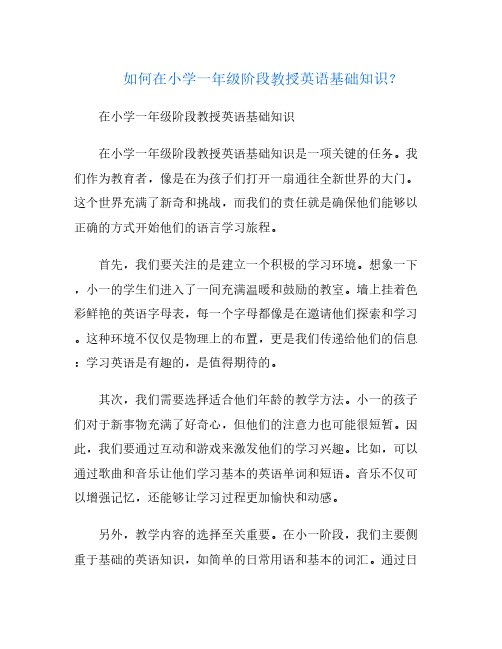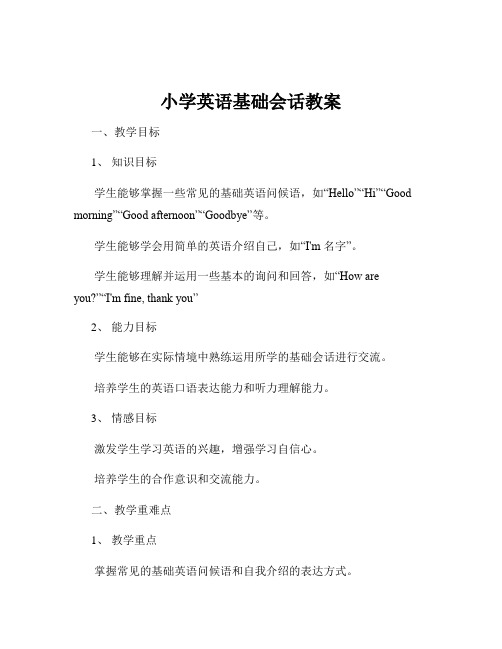小学英语基础知识教学
小学英语教育教学教案设计(精选9篇)

小学英语教育教学教案设计(精选9篇)(经典版)编制人:__________________审核人:__________________审批人:__________________编制单位:__________________编制时间:____年____月____日序言下载提示:该文档是本店铺精心编制而成的,希望大家下载后,能够帮助大家解决实际问题。
文档下载后可定制修改,请根据实际需要进行调整和使用,谢谢!并且,本店铺为大家提供各种类型的经典范文,如总结报告、心得体会、应急预案、会议记录、条据书信、合同协议、规章制度、教学资料、作文大全、其他范文等等,想了解不同范文格式和写法,敬请关注!Download tips: This document is carefully compiled by this editor. I hope that after you download it, it can help you solve practical problems. The document can be customized and modified after downloading, please adjust and use it according to actual needs, thank you!Moreover, our store provides various types of classic sample essays, such as summary reports, insights, emergency plans, meeting minutes, evidence letters, contract agreements, rules and regulations, teaching materials, essay summaries, and other sample essays. If you would like to learn about different sample formats and writing methods, please pay attention!小学英语教育教学教案设计(精选9篇)小学英语教育教学教案设计(精选9篇)2024-04-14 12:07:23小学英语教学设计(精选6篇)推荐度:小学英语教学设计范文最新6篇推荐度:热点范文英语(英文:English)是一种西日耳曼语支,最早被中世纪的英国使用,并因其广阔的殖民地而成为世界使用面积最广的语言。
小学英语学习的基础知识与技能

小学英语学习的基础知识与技能小学阶段是孩子们开始接触英语学习的重要阶段,为了帮助孩子们建立良好的学习基础,掌握必要的英语知识和技能,以下是针对小学英语学习的基础知识与技能的详细介绍。
1. 英文字母和音标:英文字母是英语学习的基础,孩子们需要正确地识别和拼读英文字母。
同时,对于不同的发音也需要进行学习,如音标。
音标能够帮助孩子们准确地发音和拼写单词,为日后的学习打下坚实的基础。
2. 基本词汇:在学习英语的初期,孩子们需要掌握一些基本的词汇,如数字、颜色、动物、家庭成员等。
通过学习这些基础词汇,孩子们可以建立起与日常生活相关的词汇积累,为扩大词汇量打下基础。
3. 日常用语:掌握一些常见的日常用语对于日常交流至关重要。
孩子们应该学习一些问候语、表达需求和感受的句子,这样就可以在日常生活中使用英语进行简单的交流。
4. 短语和句型:孩子们需要学习一些常用的短语和句型,以便能够在不同的情境中进行表达。
通过学习短语和句型,孩子们可以提高他们的口语表达能力,并且能够更流利地与他人交流。
5. 基础语法知识:在学习英语的过程中,了解一些基本的语法知识是必要的。
例如,学习主谓一致、动词时态、形容词和副词的用法等。
了解这些基础语法知识可以帮助孩子们避免语法错误,并提高他们的写作和口语能力。
6. 听说读写综合技能:小学阶段的英语学习应注重培养听、说、读、写四个方面的综合能力。
通过多听、多说、多读和多写的练习,孩子们可以提高他们的英语听力、口语表达、阅读理解和写作能力。
7. 合作学习和实践:小学英语学习应该注重培养合作学习和实践能力。
并与同伴一起参与英语学习活动,进行英语对话练习,创设情境进行角色扮演,这样可以帮助孩子们更好地理解和应用所学的英语知识。
8. 多媒体学习资源:在现代科技发达的今天,多媒体学习资源如音频、视频、电子课本等可以有效地帮助孩子们学习英语。
通过利用多媒体学习资源,孩子们可以更加直观地理解和掌握英语知识和技能。
如何在小学一年级阶段教授英语基础知识?

如何在小学一年级阶段教授英语基础知识?在小学一年级阶段教授英语基础知识在小学一年级阶段教授英语基础知识是一项关键的任务。
我们作为教育者,像是在为孩子们打开一扇通往全新世界的大门。
这个世界充满了新奇和挑战,而我们的责任就是确保他们能够以正确的方式开始他们的语言学习旅程。
首先,我们要关注的是建立一个积极的学习环境。
想象一下,小一的学生们进入了一间充满温暖和鼓励的教室。
墙上挂着色彩鲜艳的英语字母表,每一个字母都像是在邀请他们探索和学习。
这种环境不仅仅是物理上的布置,更是我们传递给他们的信息:学习英语是有趣的,是值得期待的。
其次,我们需要选择适合他们年龄的教学方法。
小一的孩子们对于新事物充满了好奇心,但他们的注意力也可能很短暂。
因此,我们要通过互动和游戏来激发他们的学习兴趣。
比如,可以通过歌曲和音乐让他们学习基本的英语单词和短语。
音乐不仅可以增强记忆,还能够让学习过程更加愉快和动感。
另外,教学内容的选择至关重要。
在小一阶段,我们主要侧重于基础的英语知识,如简单的日常用语和基本的词汇。
通过日常生活中的场景和故事,我们可以帮助他们建立起英语语言的基础。
例如,通过模拟购物、玩具角色对话等活动,让他们在实际中运用所学,这样能够更好地促进他们的语言习得。
除了课堂教学,家庭和社区的支持也是至关重要的。
我们可以通过家庭作业和家长沟通来加强学校和家庭之间的联系,让孩子们在家里也能继续他们的学习。
家长们可以通过与孩子们一起唱歌、讲故事或者玩语言游戏的方式来支持他们的学习进程。
最后,我们要时刻关注每一个学生的个体差异。
在小一的年龄阶段,每一个孩子的发展和学习速度都是不同的。
因此,我们需要灵活地调整教学策略,确保每一个孩子都能够在他们自己的步调下学习和成长。
总之,在小学一年级阶段教授英语基础知识是一项需要耐心和关怀的工作。
通过营造积极的学习环境,选择合适的教学方法,精心设计教学内容,并与家庭和社区合作,我们可以为孩子们奠定坚实的语言学习基础,帮助他们在未来的学习中更加自信和成功地应对语言挑战。
小学英语的学习方法和技巧

小学英语的学习方法和技巧作为基础的语言科目,小学英语的学习是培养孩子初步英语语言能力和语感的关键。
在学习中,正确的学习方法和技巧不仅可以让孩子更好地掌握语言知识,还可以提高孩子的兴趣和自信心。
接下来将介绍一些小学英语学习方法和技巧。
一、总结单词的规律学习新单词是学习英语的基础。
我们应该通过掌握单词的词形变化和发音规律,来达到快速记忆的目的。
首先,可以了解单词的基础形式,比如动词的原型,名词的单数形式,形容词的原级等。
其次,对于同一单词不同形式的发音差异,可以注重练习单词发音的流利程度,如元音发音、辅音发音的准确性。
这样,当我们遇到一个新单词时,可以通过总结其规律进行记忆和运用,提高了我们的单词记忆效率。
二、掌握正确的语音调式英语的语音调式对于语言交流的意义重大。
学习小学英语应该从培养标准的英语语音入手,并且应该注重语音和语调的练习,这有助于更自然准确地表达和交流。
学生可通过模仿老师说单词和句子;听录音并追读等方法来提高语音水平。
同时,学习英语不只是学习语音的正确发音,还需要注意讲究语音的节奏和语调,这有助于和别人进行更流利和自然的交流。
三、勤于练习阅读和听力阅读和听力是学习英语的重点。
通过阅读和听力,不仅可以增加英语词汇,提高阅读理解能力,还能增加语言应用的能力。
为了提高自己的阅读和听力技能,我们可以找到内容适合自己水平的英语读物和听力材料,如课外书、英语儿童故事、英语电台等,有规律进行听读,并注重语音、语调和语速的模仿,定期进行小测验也是不错的方法。
四、及时总结所学的课文知识总结是学习的重要环节。
在学习英语的过程中,我们应该及时巩固所学知识,包括语法和单词,做到“学以致用”。
为了使记忆更加深刻,我们也可以结合自己的生活经验,把所学知识进行联想和运用。
例如,通过绘制思维导图、写文章、打游戏等方式将英语用于实际生活中,这样可以更加深入地记忆所学知识。
五、多进行实践和交流实践和交流会加速我们的学习进度。
小学一年级英语知识点归纳

小学一年级英语知识点归纳小学一年级是学习英语的起点,孩子们会接触到一些基础的英语知识。
下面是对小学一年级英语知识点的详细介绍。
一、字母1. 学习26个英文字母的名称和发音。
2. 字母的大小写形式。
3. 字母的书写顺序和笔画。
二、单词1. 学习一些基本的英文单词,如颜色、数字、动物、水果等。
2. 通过图片和发音来记忆和认识这些单词。
3. 初步了解单词的中英文意思,并能在简单的情景中运用。
三、日常用语1. 学习一些常见的日常用语,如问候语、感谢语、道歉语等。
2. 学会用简单的句子表达自己的需求和意愿。
3. 运用所学的日常用语进行简单的对话。
四、基本语法1. 学习英语的名词、代词、动词、形容词等基本词类,初步了解它们在句子中的作用。
2. 了解英语中的主谓一致规则。
3. 学习英语中的人称代词和物主代词。
五、基本句型1. 学习英语中的基本句型,如主谓结构、主谓宾结构等。
2. 能用简单的句子描述一些常见的事物和人物。
3. 学会用一般疑问句和肯定回答、否定回答来进行简单的对话。
六、阅读1. 通过简单的绘本和故事来培养学生的阅读兴趣。
2. 学习正确地发音和模仿绘本中的语音和语调。
3. 开始听懂一些简单的绘本和故事,并能理解其中的基本意思。
七、写作1. 学习正确书写字母和单词。
2. 尝试用英语表达自己的想法和感受,写一些简单的句子和段落。
3. 学习使用一些常见的标点符号和英文缩写。
以上是小学一年级英语知识点的详细介绍。
这些知识点都是孩子们在学习英语的初期需要掌握的基础,通过学习这些知识点,可以培养孩子们的英语兴趣,同时也为后续的英语学习打下坚实的基础。
在学习英语的过程中,多与孩子进行口语交流和阅读训练,让他们能够在实践中巩固所学的知识,使英语学习更加有趣和有效。
小学英语必背基础知识

小学英语必背基础知识
《小学英语必背基础知识》
小学英语是学生接触外语的第一门门槛,基础知识的掌握对学生的英语学习起着至关重要的作用。
下面是小学英语必背的基础知识:
1. 26个字母:学生要熟练掌握26个英文字母的大小写形式,以及它们的发音和字母顺序。
2. 常见的颜色:红色、绿色、蓝色、黄色、黑色、白色等,学生要能够准确地认识并描述这些颜色。
3. 基本数字:学生需要掌握基础的数字0-100的读法和写法,以及简单的四则运算。
4. 基本的问候语:学生要学会用英语问候他人,比如“Hello!”,“How are you?”等常用的问候语。
5. 常见的动物和植物:学生应该能够认出一些常见的动物和植物的英文名称,比如dog、cat、flower等。
6. 基础的日常用语:学生要具备一些基本的日常用语,比如“Can I go to the bathroom?”、“May I have some water?”等。
以上是小学英语必背的基础知识,这些知识对学生的英语学习起着重要的基础作用,帮助学生打下坚实的英语学习基础。
小学英语基础会话教案

小学英语基础会话教案一、教学目标1、知识目标学生能够掌握一些常见的基础英语问候语,如“Hello”“Hi”“Good morning”“Good afternoon”“Goodbye”等。
学生能够学会用简单的英语介绍自己,如“I'm 名字”。
学生能够理解并运用一些基本的询问和回答,如“How are you?”“I'm fine, thank you”2、能力目标学生能够在实际情境中熟练运用所学的基础会话进行交流。
培养学生的英语口语表达能力和听力理解能力。
3、情感目标激发学生学习英语的兴趣,增强学习自信心。
培养学生的合作意识和交流能力。
二、教学重难点1、教学重点掌握常见的基础英语问候语和自我介绍的表达方式。
能够正确运用“How are you?”及其回答。
2、教学难点让学生在实际情境中自然、流利地运用所学会话进行交流。
纠正学生的发音,培养正确的语音语调。
三、教学方法1、情景教学法通过创设生动的情景,让学生在实际情境中感受和学习英语会话。
2、游戏教学法设计有趣的游戏,让学生在轻松愉快的氛围中巩固所学知识。
3、小组合作学习法组织学生进行小组合作学习,培养学生的合作意识和交流能力。
四、教学过程1、导入(5 分钟)播放一首简单的英语歌曲,如“Hello Song”,让学生跟着歌曲一起唱,营造英语学习的氛围。
展示一些与问候和自我介绍相关的图片,如小朋友打招呼、互相介绍自己等,引导学生进入本节课的主题。
2、知识讲解(10 分钟)教师用英语向学生打招呼,如“Hello, boys and girls!”,引导学生用“Hello”或“Hi”回应。
依次教授“Good morning”“Good afternoon”“Goodbye”等问候语,让学生跟读,并通过师生互动、生生互动进行练习。
教师示范自我介绍:“I'm 教师名字”,然后让学生模仿,用“I'm 自己名字”进行自我介绍。
讲解“How are you?”的用法及回答方式,如“I'm fine, thank you”“I'm not very well”,并让学生进行角色扮演练习。
小学英语教案(通用15篇)

小学英语教案(通用15篇)小学英语教案1一、教学内容今天我说课的内容是上海版牛津英语Module 2 Unit3 Drinks I like的第一课时,通过信息技术的运用,学习单词thirsty, milk, juice和句型“What drink do you like? I like …”本节课是在学生学习“I like …”之后进行教学的。
通过学习thirsty,感知句形“What drink do you like? I like …”本课时的难度是句型的运用,以及对饮料的简单描述,但容量不是很大,并受到学生的喜爱。
二、教学目标《英语课程标准》指出:激发和培养学生学习英语的兴趣,使学生树立自信心,养成良好的学习习惯和形成有效的学习策略,发展学生自主学习的能力和合作精神是小学英语教学的基本任务。
在认真分析教材的基础上,我针对学生实际,结合信息技术,将本课时的教学目标及重,难点确定如下:1、知识目标( 1 )学会用thirsty, milk, juice等表述单词。
( 2 )理解和初步运用“What drink do you like? I like …”2、能力目标( 1 )能用“What drink do you like?”来询问他人所喜爱的饮料。
( 2 )会用“I like ….”句型回答他人的询问。
( 3 )能简单描述自己所喜欢的饮料。
3、情感目标( 1 )懂得健康饮食,均衡饮食。
( 2 )学会感恩,学会感谢帮助自己的人。
三、教学重难点1、教学重点:理解和运用新授单词,理解和初步运用新授句型。
2、教学难点:能正确表达自己喜欢的饮料,并且进行描述。
四、教学准备教师准备单词卡片、图片、实物、媒体。
五、教学过程整堂课我利用现代教学媒体,充分向学生展示适当的语境,准确呈现语言信息,并且利用多媒体创设的情境进行合作互助学习,学习自由发挥运用英语的能力。
通过信息技术的运用,更好地实现教师和学生之间和谐高效教学过程,达成教学目标。
- 1、下载文档前请自行甄别文档内容的完整性,平台不提供额外的编辑、内容补充、找答案等附加服务。
- 2、"仅部分预览"的文档,不可在线预览部分如存在完整性等问题,可反馈申请退款(可完整预览的文档不适用该条件!)。
- 3、如文档侵犯您的权益,请联系客服反馈,我们会尽快为您处理(人工客服工作时间:9:00-18:30)。
Introduction to basic knowledge of primary school Chinese teachingLongshan primary school Hong-mei liuEverybody is good! Here is my pleasure to share with you my views on basic knowledge of primary school Chinese teaching. The development of anything from quantitative change to qualitative change, and from qualitative to quantitative change new. Primary school Chinese teaching, students to understand Chinese characters one by one, reach a certain amount, can read; Reading reaches a certain amount, can the composition. As the ancients cloud: "qian fu can read, could give." Primary school Chinese basic knowledge including pinyin, read, write, and so on aspects. To break through the primary school Chinese basic knowledge of the difficulties, we must also take corresponding measures in practice:A, stimulate students interestOne is to make the students like their teacher. So there's a phrase said "a successful teacher, itself is a textbook". I think it is a successful teacher's standard, we should all efforts to push yourself to this realm. In the face of students, we should let our students have confidence in their teacher, admire his teacher. We can in their own personality, accomplishment and love to let the students like himself. Like teacher, like class, like on the subject, resulting in a very strong interest in learning.The second is to get the basic knowledge of classroom to life. Students can concentrate to the observing time generally can't more than thirty minutes, it must make good use of the precious time in class, improve the efficiency of their classroom. Especially the language basic knowledge learning is boring, more should make the classroom to life. We should use of textbooks, give students the opportunity to play, let them become a real master. I often and students together play a role, in this way, students can help themselves by the movements of the rich expression and interesting to understand the text, understand the meaning of them. Second, I will also according to the content and characteristics of Chinese basic knowledge teaching, to carry out some activities, such as looking for wrong character, tone of voice, speech sounds game solitaire, etc., these activities can sometimes influence the teaching process, but students in activities to cultivate the study interest, also improves the ability of learning.Second, pay attention to teaching methodsOne is focusing the difficulty, the breakthrough "pinyin". Chinese phonetic knowledge is the foundation of students to learn the language, and learn the language. How to let the students can learn this seemingly boring knowledge lively and interesting, but also a good grasp of, I communicate with school teachers often, and learn from their experience in teaching, to make students learn easily, learn more solid. Chinese pinyin is the tool that helps literacy, reading and learning mandarin. Students learning difficulties are often characterized by flat become warped lingual regardless, im read not to come out, and lateral nasal is difficult to distinguish. To these questions can be used with the aid of the Chinese characters sound learning pinyin and categorized resolution method.2 it is to know a word to recognize more words, the breakthrough "literacy". As soon as possible in order to improve the efficiency of the literacy teaching, make students master the 3500 or so commonly, in the literacy teaching, we can make full use of the characteristics of lenovo literacy, let the students to master Chinese characters, and guide students to lenovo, through has carried off some commonly used Chinese characters, teach students reading (teaching we referred to as "more than a word with the word"). Here is the main method is: to familiar with life: born by a familiarwords. "Wood" is a familiar words such as "mouth", through the two words can bring out the "stay" "apricot" "trapped" and other words. Radical with words: born with word by increase or decrease parts. Such as teach "fang", from "party", the word "party" with grass character head, is that "fang", combined with single side is "imitation", combined with soil is "fang", plus the hinge side is "spinning", and "family" is the "room" and so on. And to change parts of belt, comparison with words, find friends, string of words words, do puzzles and so on.Third, standardized writing, breakthrough in writing. Can let each student to write good words, is my biggest wish. So, in the usual teaching work, I pay attention to training students' writing. First of all, to let the students write good word, as their Chinese teacher, I pay more attention to their own yes blackboard writing in class, to the student's notes, etc, do a good demonstration to students. Second, I make full use of the writing class, guide students to learn to read the post, MiaoGong, such requirements from skills students, cultivate students from the aspects of habit. Especially the cultivation of habits, such as how to hold a pen, how to keep writing posture, these often easy to overlook, but was precisely these influences the improvement of the quality of the students' writing, I pay more attention to the students have good writing habits. At the same time is closely linked to write and to read, write classes per week pencil writing, training students in writing, to write a good post praise encouraged. Wrong character in a timely manner to correct in students' work, students are required to write up. Every lesson words dictation or see pinyin write words of practice, the students use of words is not pass their spare time to do.Four is have feelings to read, through reading. To cultivate elementary student's reading ability is an important content of Chinese language teaching in primary school, is also one of the most important aspects of the implementation of quality education of Chinese. To read texts have feelings will help students correctly understand and express the thoughts and feelings of the text, also helps to develop thinking, rich imagination, arouse emotion, enhance understanding and memory. First of all, pay attention to cultivate the students' reading ability in teaching, use of morning reading let the students read more books, class, I often set up all kinds of reading competition, team, men and women, smoking read, teach normal form of life in a certain extent, inspired the students' interest in reading; Secondly, I pay attention to in the process of reading teaching, students can open the wings of imagination, as far as possible to read your feelings. Again, begin read comments, improve students in the lessons learned, in reading aloud, often have the phenomenon of "distance, outsider", in order to let the students know their reading level and the existing problems, and can let the students around the sound, pause, fluent expression, evaluation appraisal, have feelings, etc. On the one hand the students deepen the understanding of the text in the review, further understand the text expression of emotion; On the other hand, the students to realize their own reading success in the deliberations and deficiency, summarize experience, improve reading ability.Third, raises the student good habits of studentsUsed to make good. Language learning also has a lot of good habits, as long as insist for a long time, and there will be achieved. Since the succession, I have own a set of methods. In simple terms, I focus on cultivating the students seriously preview, make notes in the book, questioned the difficult, often the dictionary and write diary diary has habit. Another is "there is a wrong will change" habit, every time, mistakes in your papers, especially the dictation, I give time to let the students in the classroom in a timely manner to modify, so as not to forget. Most of the students learning consciousness is not strong, after all.I also pay attention to students' correct wrong topic, practice has proved that it is the improvement of excellent student performance and top has a prominent role. Is made of the wrong topic set, including in the usual test and self-test, those who do wrong and won't do the topic together, carefully analyse the causes of mistakes: belongs to intellectual defect, wrong, or to their oversight wrong topic, oneself feel and inspired, a detailed review and record, often see in the future. I emphasize must repeatedly before the exam.As a young teacher, I have yet to be innovative and flexible teaching methods, teaching businessimprove the development of double themselves, improve their quality, achieve better results. I hope the leaders the teacher can continue to help me, let me grow faster.。
